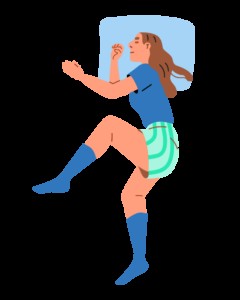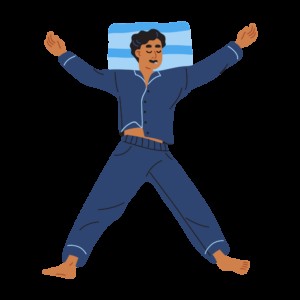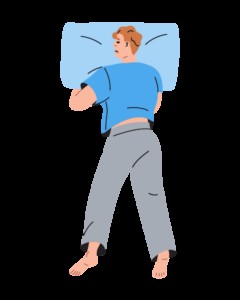What Is The Best Position To Sleep In? It’s a question many ponder, seeking optimal rest and rejuvenation. At WHAT.EDU.VN, we understand the importance of a good night’s sleep and how sleep posture affects your overall well-being. Discover the ideal sleep arrangement for spinal alignment, pain relief, and enhanced sleep quality, while exploring helpful tips for adopting better sleep habits. Let’s delve into sleep ergonomics, sleep wellness, and find out how to achieve restful slumber.
1. Understanding The Fundamentals Of Sleep Positions
The best position to sleep in significantly influences your physical and mental health. During sleep, your body repairs and restores itself. Proper spinal alignment is crucial during this process. An ideal sleeping posture ensures your spine maintains its natural curvature, reducing strain and promoting muscle relaxation. Let’s explore the fundamental aspects that make a sleeping position beneficial or detrimental.
1.1 Spinal Alignment: The Key To Comfortable Sleep
Maintaining healthy spine alignment from your head to your hips is paramount. A well-aligned spine ensures that the weight of your body is evenly distributed, minimizing pressure on any single point. When the spine is properly aligned, muscles can relax fully, promoting recovery and reducing the likelihood of waking up with aches and pains.
1.2 Common Sleep Positions And Their Effects
People adopt various sleep positions, each with unique implications for spinal health. Common sleep positions include side sleeping, back sleeping, and stomach sleeping. Side and back sleeping generally support better spinal alignment than stomach sleeping. Let’s delve into the effects of each position.
- Side Sleeping: This posture often promotes spinal alignment and can alleviate snoring and heartburn.
- Back Sleeping: It evenly distributes body weight and can relieve nasal congestion.
- Stomach Sleeping: This position tends to misalign the spine and can exacerbate back and neck pain.
1.3 Factors Influencing Your Ideal Sleep Position
Several factors influence the best position to sleep in for you. These include:
- Health Conditions: Pre-existing conditions like back pain, pregnancy, or sleep apnea can dictate the most suitable sleep posture.
- Body Type: Your body’s shape and weight distribution can affect comfort and spinal alignment in different positions.
- Personal Comfort: Ultimately, the position in which you feel most comfortable and relaxed is likely the one that will provide the best sleep quality.
2. Side Sleeping: Benefits, Drawbacks, And Variations
More than 60% of individuals prefer side sleeping. Men tend to spend more time on their sides than women. The flexibility of our spine decreases as we age, which may make the side sleeping position more comfortable for older adults. Side sleeping offers numerous benefits, but it also has potential drawbacks to consider.
2.1 Advantages Of Side Sleeping
Side sleeping offers several advantages, including:
- Spinal Alignment: Promotes healthy spinal alignment, reducing back pain.
- Reduced Snoring: Helps keep airways open, decreasing snoring.
- Heartburn Relief: Can alleviate heartburn symptoms by preventing stomach acid from flowing back into the esophagus.
- Benefits for Pregnancy: Recommended for pregnant women to relieve pressure on the uterus and promote healthy blood flow.
2.2 Ideal For Specific Conditions
Side sleeping is particularly beneficial for individuals with:
- Pregnancy: Especially on the left side, to improve blood flow to the fetus, uterus, and kidneys.
- Acid Reflux: It reduces the likelihood of stomach acid rising into the esophagus.
- Back Pain: Provides support and reduces strain on the spine.
- Sleep Apnea: Helps keep airways open, reducing sleep apnea episodes.
2.3 Potential Drawbacks To Consider
Despite its benefits, side sleeping can have drawbacks:
- Shoulder Pain: It may cause soreness or tightness in the shoulders due to pressure.
- Facial Wrinkles: Pressing the face against the pillow can contribute to wrinkles.
2.4 Optimizing Side Sleeping For Comfort
To maximize comfort and minimize drawbacks, consider these tips:
- Use a Supportive Pillow: Choose a pillow with a loft that matches the distance between your neck and shoulder.
- Mattress Support: Ensure your mattress has enough “give” to allow your hips and shoulders to sink in deeper than your middle spine.
- Switch Sides: Alternate between sleeping on your left and right sides to relieve pressure.
2.5 Which Side Is Better? Left Vs. Right
Sleeping on your left side is generally considered better. It reduces pressure on internal organs and improves blood flow. Experts often recommend it for pregnant women and those with acid reflux or GERD. Sleeping on the right side may intensify heartburn symptoms.
3. Back Sleeping: How It Helps, Who Should Avoid It
Lying on the back is the second most popular sleep position. It offers plenty of benefits. When you’re flat on your back, it’s easy to keep your spine in alignment and to evenly distribute your body weight. This prevents potential aches in the neck or back. Sleeping on the back can also relieve the congestion of a stuffy nose or allergies, so long as you prop yourself up into an upright position.
3.1 Key Benefits Of Back Sleeping
Back sleeping provides several advantages:
- Spinal Alignment: Keeps the spine aligned, preventing neck and back pain.
- Even Weight Distribution: Distributes body weight evenly, reducing pressure points.
- Reduces Wrinkles: Prevents facial contact with the pillow, minimizing wrinkles.
- Nasal Congestion Relief: It can help relieve nasal congestion when the upper body is propped up.
3.2 Best For Specific Needs
Back sleeping is particularly beneficial for:
- Lumbar Spinal Pain: Supports the natural curvature of the spine.
- Wrinkle Prevention: Avoids pressure on the face, reducing wrinkles.
- Neck Pain: Prevents misalignment that can occur in other positions.
- Nasal Congestion: Elevating the upper body can help drain nasal passages.
3.3 Who Should Avoid Back Sleeping?
Despite its benefits, back sleeping is not recommended for everyone:
- Pregnant Women: It can add pressure on the heart and hinder blood flow.
- Snoring And Sleep Apnea: It may worsen snoring and sleep apnea symptoms.
- GERD Or Acid Reflux: Lying flat can allow stomach acid to flow back into the esophagus.
- Heavier Adults: It can make breathing more difficult due to gravity’s pressure on the body.
- Older Adults: May experience breathing difficulties in this position.
3.4 Optimizing Back Sleeping For Comfort
To improve comfort and minimize potential issues:
- Use a Supportive Pillow: Choose a pillow that supports the neck while allowing the head to sink deeper.
- Pillow Under Knees: Place a pillow under your knees to maintain the spine’s natural curve.
- Avoid Lying Flat: Prop up your upper body with pillows to help with nasal congestion.
3.5 Potential Drawbacks To Consider
Back sleeping can also pose some challenges:
- Worsens Snoring: It can exacerbate snoring due to airway collapse.
- Increases Back Pain: For some, it can increase back pain if the mattress doesn’t provide adequate support.
4. Stomach Sleeping: Why It’s Generally Discouraged
The stomach is the least popular sleep position. Research suggests we spend less than 10% of our night sleeping in this position. Stomach sleeping does have some benefits, however. The stomach sleeping position can help relieve snoring, by opening up your airway.
4.1 The Drawbacks Of Stomach Sleeping
Stomach sleeping is generally discouraged due to several drawbacks:
- Spinal Misalignment: It places significant pressure on the spine.
- Neck Pain: It requires turning the head to one side, causing neck strain.
- Back Pain: It can exacerbate existing back pain issues.
- Facial Wrinkles: Pressing the face against the pillow contributes to wrinkles.
4.2 Who Should Definitely Avoid It
Stomach sleeping should be avoided by:
- Pregnant Women: It puts pressure on the abdomen and spine.
- People With Neck Or Back Pain: It worsens existing pain conditions.
- People Worried About Wrinkles: It increases the risk of facial wrinkles.
4.3 Possible Benefits
Despite its drawbacks, stomach sleeping can offer some benefits:
- Snoring Relief: It can help open up airways, reducing snoring.
4.4 How To Minimize Negative Effects
If you must sleep on your stomach, consider these tips:
- Use a Thin Pillow: Avoid tilting your neck back, which can cause spinal misalignment.
- Pillow Under Hips: Place a thin pillow under your hips to even out the spine.
- Firm Mattress: Use a firm mattress to prevent sinking and spinal strain.
4.5 Minimizing Spinal Stress
To reduce spinal stress while stomach sleeping:
- Stretch Regularly: Perform neck and back stretches to relieve tension.
- Maintain Good Posture: Practice good posture during the day to support spinal health.
- Consider Alternatives: Explore other sleeping positions that promote better spinal alignment.
5. Alternative Sleep Positions
Beyond the main three, several alternative sleep positions cater to different preferences and needs. These positions often combine aspects of side, back, and stomach sleeping to provide unique comfort.
5.1 Common Variations
- Fetal Position: A curled-up version of side sleeping, providing a sense of security and comfort.
- Yearner: Side sleeping with arms stretched out in front, often chosen for comfort.
- Log: Side sleeping with a straight body, maintaining spinal alignment.
- Soldier: Back sleeping with arms at the sides, promoting even weight distribution.
- Starfish: Back sleeping with limbs extended, allowing for full relaxation.
- Cliffhanger: When couples sleep on opposite sides of the bed, right up against the edges, with their backs towards each other.
- Freefall: Stomach sleeping with hands around or under the pillow and head turned to the side.
5.2 Combination Sleepers
Many individuals are combination sleepers, switching positions throughout the night. This approach can help distribute pressure and prevent stiffness. Combination sleepers should prioritize spinal alignment in each position.
5.3 Finding What Works Best For You
Experimenting with different positions and variations can help you discover the most comfortable and beneficial sleep posture. Consider factors like health conditions, body type, and personal preferences.
6. Tips For Improving Your Sleep Environment
Beyond sleep position, your sleep environment significantly affects sleep quality. Creating a conducive environment can enhance relaxation and promote restful sleep.
6.1 Mattress Selection
Choosing the right mattress is crucial. Consider the following:
- Firmness: Select a firmness level that supports your preferred sleep position and spinal alignment.
- Material: Options like memory foam, latex, and innerspring offer varying levels of support and comfort.
- Pressure Relief: Ensure the mattress provides adequate pressure relief to prevent aches and pains.
6.2 Pillow Selection
The right pillow can make a significant difference:
- Loft: Choose a loft (thickness) that aligns your neck with your spine in your preferred sleep position.
- Material: Options like memory foam, down, and buckwheat offer different levels of support and comfort.
- Support: Ensure the pillow provides adequate neck support to prevent pain and stiffness.
6.3 Room Environment
Optimize your bedroom environment:
- Temperature: Keep the room cool, ideally between 60-67°F (15-19°C).
- Darkness: Block out light with blackout curtains or a sleep mask.
- Noise: Minimize noise with earplugs or a white noise machine.
- Cleanliness: Maintain a clean and clutter-free room to promote relaxation.
6.4 Bedtime Routine
Establish a relaxing bedtime routine:
- Consistent Schedule: Go to bed and wake up at the same time each day, even on weekends.
- Relaxation Techniques: Practice relaxation techniques like meditation, deep breathing, or yoga.
- Avoid Stimulants: Avoid caffeine, alcohol, and nicotine before bed.
- Limit Screen Time: Reduce exposure to electronic devices before bed to minimize blue light exposure.
6.5 The Role Of Sleep Aids
Consider using sleep aids:
- White Noise Machines: These can mask disruptive noises and promote relaxation.
- Humidifiers: They can help with nasal congestion by adding moisture to the air.
- Aromatherapy: Scents like lavender and chamomile can promote relaxation.
7. Addressing Specific Health Concerns Through Sleep Positions
Specific health conditions can significantly influence the best position to sleep in. Understanding these conditions and their relationship to sleep posture is essential for maximizing comfort and promoting better health.
7.1 Back Pain
- Recommended Positions: Side sleeping with a pillow between the knees or back sleeping with a pillow under the knees.
- Positions To Avoid: Stomach sleeping, as it can exacerbate back pain.
7.2 Neck Pain
- Recommended Positions: Back sleeping with a supportive pillow or side sleeping with a pillow that aligns the neck and spine.
- Positions To Avoid: Stomach sleeping, as it can cause neck strain.
7.3 Acid Reflux (GERD)
- Recommended Positions: Left-side sleeping, as it reduces pressure on the stomach and prevents acid from flowing back into the esophagus.
- Positions To Avoid: Right-side sleeping and back sleeping, as they can worsen acid reflux symptoms.
7.4 Sleep Apnea And Snoring
- Recommended Positions: Side sleeping, as it helps keep airways open and reduces snoring.
- Positions To Avoid: Back sleeping, as it can lead to airway collapse and worsen sleep apnea symptoms.
7.5 Pregnancy
- Recommended Positions: Left-side sleeping, as it improves blood flow to the fetus, uterus, and kidneys.
- Positions To Avoid: Back sleeping, especially in the later stages of pregnancy, as it can put pressure on the heart and hinder blood flow.
7.6 Managing Allergies And Nasal Congestion
- Recommended Positions: Back sleeping with the upper body propped up with pillows, as it helps drain nasal passages.
- Positions To Avoid: Lying flat on the back, as it can increase nasal congestion.
7.7 Shoulder Pain
- Recommended Positions: Sleeping on the non-affected side or back sleeping.
- Positions To Avoid: Sleeping on the affected side, as it can exacerbate shoulder pain.
8. Common Questions About The Best Position To Sleep In
Navigating the world of sleep positions can raise many questions. Here are some frequently asked questions to help you better understand and optimize your sleep posture.
| Question | Answer |
|---|---|
| Is there one best sleeping position for everyone? | No, the best sleeping position varies depending on individual health conditions, body type, and personal preferences. Side and back sleeping are generally considered healthier than stomach sleeping, but the ideal position depends on your unique needs. |
| How can I train myself to sleep in a new position? | Start by consciously choosing the desired position as you fall asleep. Use pillows to support your body and prevent rolling over. Be patient, as it may take time to adjust. Consistency is key. |
| What type of pillow is best for each sleeping position? | For side sleeping, choose a pillow with a loft that matches the distance between your neck and shoulder. For back sleeping, select a pillow that supports the neck while allowing the head to sink deeper. For stomach sleeping, use a very thin pillow or no pillow at all. |
| How does mattress firmness affect sleeping position? | The right mattress firmness supports spinal alignment and prevents pressure points. Side sleepers may prefer a softer mattress that allows the hips and shoulders to sink in, while back and stomach sleepers may benefit from a firmer mattress for better support. |
| Can my sleeping position affect my skin? | Yes, sleeping on your side or stomach can contribute to facial wrinkles due to the pressure and friction between your face and the pillow. Back sleeping is often recommended to minimize wrinkles. |
| Is it normal to change sleeping positions throughout the night? | Yes, many people change sleeping positions throughout the night. Combination sleeping can help distribute pressure and prevent stiffness. Focus on maintaining spinal alignment in each position. |
| How can I improve my sleep quality regardless of position? | Maintain a consistent sleep schedule, create a relaxing bedtime routine, optimize your sleep environment, and avoid stimulants before bed. Additionally, ensure your mattress and pillow support proper spinal alignment in your preferred sleeping position. |
| What should I do if I wake up with pain? | Assess your sleeping position and adjust as needed. Consider changing your mattress or pillow to provide better support. Perform gentle stretches to relieve tension and consult a healthcare professional if the pain persists. |
| Can sleep position affect my breathing? | Yes, back sleeping can worsen snoring and sleep apnea due to airway collapse. Side sleeping is often recommended to keep airways open. Elevating your upper body with pillows can help with nasal congestion. |
| How do I choose the best sleeping position during pregnancy? | Left-side sleeping is generally recommended during pregnancy, as it improves blood flow to the fetus, uterus, and kidneys. Use pillows to support your belly and back. Avoid back sleeping, especially in the later stages of pregnancy. |



9. Expert Insights On Optimizing Sleep
Experts emphasize the importance of personalized approaches to sleep optimization. Considering individual needs and preferences is crucial for achieving restful sleep and overall well-being.
9.1 Advice From Sleep Specialists
- Dr. Michael Breus (The Sleep Doctor): Highlights the importance of finding a sleep position that supports spinal alignment and minimizes pressure points.
- Dr. Matthew Walker (Sleep Scientist): Emphasizes the role of sleep in overall health and cognitive function, encouraging individuals to prioritize sleep optimization.
- Dr. Meir Kryger (Sleep Medicine Expert): Recommends addressing underlying sleep disorders and optimizing the sleep environment for better sleep quality.
9.2 The Importance Of Consistency
Consistency is key to regulating the body’s internal clock and promoting restful sleep. Maintaining a consistent sleep schedule, even on weekends, can improve sleep quality and overall health.
9.3 The Role Of Professional Guidance
If you experience persistent sleep problems or have specific health concerns, consulting a healthcare professional or sleep specialist is essential. They can provide personalized recommendations and address any underlying issues affecting your sleep.
10. Ready To Sleep Better?
Finding the best position to sleep in is a personalized journey that requires understanding your body’s unique needs. At WHAT.EDU.VN, we strive to provide you with the information and resources to make informed decisions about your sleep health.
10.1 Still Have Questions?
If you have more questions or need personalized advice, don’t hesitate to reach out. Our team of experts is here to help you navigate the complexities of sleep and find the best solutions for your individual needs.
10.2 Contact Us Today
Address: 888 Question City Plaza, Seattle, WA 98101, United States
WhatsApp: +1 (206) 555-7890
Website: WHAT.EDU.VN
10.3 Ask Your Questions For Free
At WHAT.EDU.VN, we understand the challenges of finding reliable and accessible information. That’s why we offer a free platform for you to ask any questions you may have. Whether it’s about sleep positions, health concerns, or optimizing your sleep environment, our community is here to provide answers and support.
10.4 Call To Action
Don’t let sleep problems affect your health and well-being. Visit what.edu.vn today and ask your questions for free. Let us help you find the best position to sleep in and achieve the restful, rejuvenating sleep you deserve. Because everyone deserves a good night’s sleep, and we’re here to make it easier than ever.
